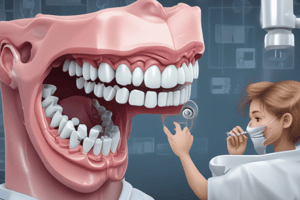Podcast
Questions and Answers
What are the types of origins of developmental disorders of teeth?
What are the types of origins of developmental disorders of teeth?
Prenatal, postnatal, inherited, and acquired.
What is hypodontia, and which teeth are commonly involved?
What is hypodontia, and which teeth are commonly involved?
Hypodontia is a condition characterized by the absence of one or more teeth. The teeth commonly involved are third molars, permanent maxillary lateral incisors, and mandibular second premolars.
What is hypohidrotic ectodermal dysplasia, and what are its characteristic features?
What is hypohidrotic ectodermal dysplasia, and what are its characteristic features?
Hypohidrotic ectodermal dysplasia is a genetic disorder characterized by congenital absence of ectodermal structures. Its features include smooth and dry skin, fine and sparse hair, partial or total absence of sweat glands, and defective fingernails.
What are the requirements for the development of an ideal dentition?
What are the requirements for the development of an ideal dentition?
What is the term for a supernumerary tooth that erupts alongside a maxillary molar?
What is the term for a supernumerary tooth that erupts alongside a maxillary molar?
What is the most common supernumerary tooth?
What is the most common supernumerary tooth?
What is hyperdontia, and in which regions of the jaw does it commonly occur?
What is hyperdontia, and in which regions of the jaw does it commonly occur?
What is the clinical implication of hyperdontia on oral health?
What is the clinical implication of hyperdontia on oral health?
What is the term for a supernumerary tooth that develops distal to the third molar?
What is the term for a supernumerary tooth that develops distal to the third molar?
What is the syndrome characterized by multiple osteomas of the jaws, skin cysts and fibromas, and abnormal root formation?
What is the syndrome characterized by multiple osteomas of the jaws, skin cysts and fibromas, and abnormal root formation?
Flashcards are hidden until you start studying
Study Notes
Requirements for Development of Ideal Dentition
- Formation of a full complement of teeth
- Normal structural development of dental tissues
- Eruption of each tooth at an appropriate time into proper space
- Correct relationship of teeth in opposite arches
Origin of Developmental Disorders
- Prenatal
- Postnatal
- Inherited
- Acquired
Developmental Disorders
- Abnormalities of morphodifferentiation: Abnormalities in formation of dental hard tissue
- Abnormalities of histodifferentiation: Abnormalities in differentiation of dental lamina & tooth germ
Abnormalities in the Number of Teeth
- Anodontia: Absence of teeth
- Hypodontia: Partial anodontia, more commonly found in permanent dentition and in females
- Hyperdontia: Additional teeth beyond the normal series, also known as supernumerary teeth
Anodontia
- Partial anodontia is also known as oligodontia
- Teeth commonly involved: third molars, permanent maxillary lateral incisors, mandibular second premolars
- Associated with many syndromes, including:
- Cleft lip and palate
- Crouzon syndrome: characterized by craniosynostosis, maxillary hypoplasia, and hypertelorism
- Down syndrome
- Hypohidrotic ectodermal dysplasia
- Ellis Van Creveld syndrome
- Oral-facial-digital syndrome
Hypohidrotic Ectodermal Dysplasia
- Characterized by:
- Congenital absence of the ectodermal structures
- X-linked recessive trait
- Abnormal development of skin, hair, sweat glands, and nails
- Patients affected with the syndrome show abnormal development of the following structures:
- Skin: smooth, dry
- Hair: fine, sparse, scanty
- Sweat Glands: partial or total absence
- Nails: fingernails are usually defective
Hyperdontia
- Can be classified according to:
- Shape: conical, tuberculate, supplemental
- Position: mesiodens, paramolar, distomolar
- Causes of hyperdontia:
- Continuous proliferation of the permanent or primary dental lamina
- Presence of a second tooth bud
- Splitting of a regular tooth bud
- More common in females, in permanent dentition
- Clinical implications:
- Esthetics affected
- Malpositioning of the teeth
- Dentigerous cysts
- Stagnation areas for plaque and calculus
- Associated with many syndromes, including:
- Cleft lip/palate
- Cleidocranial dysplasia
- Gardner syndrome: characterized by multiple osteomas of jaws, skin cysts and fibromas, impacted teeth other than 3rd molars, supernumerary or missing teeth, abnormal root formation, and intestinal polyposis
- Oro-facial digital syndrome
Studying That Suits You
Use AI to generate personalized quizzes and flashcards to suit your learning preferences.




